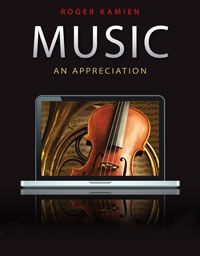Music: An Appreciation, 10th Edition (Kamien)Chapter 4:
Music NotationInteractive ChapterELEMENTS OF MUSIC: MUSIC NOTATIONNotation is a system of writing music so that specific pitches and rhythms can be communicated. It is explained here -- very briefly -- primarily to help you recognize rising and falling melodic lines and long and short notes so that you can follow the music examples in the book and on this CD. Notating Pitch We indicate pitches by the placement of symbols -- called notes -- on a staff. A note is an oval. (Its duration is indicated by whether it is black or white or has a stem and flags, as will be explained later). A staff (plural staves) is a set of five horizontal lines. Notes are positioned either on the lines of the staff or between them, in the spaces; the higher a note is placed on the staff, the higher its pitch. If a pitch falls above or below the range indicated by the staff, short, horizontal ledger lines are used.
 <a onClick="window.open('/olcweb/cgi/pluginpop.cgi?it=gif::::/sites/dl/free/0002022011/420040/staffnotes.gif','popWin', 'width=NaN,height=NaN,resizable,scrollbars');" href="#"><img valign="absmiddle" height="16" width="16" border="0" src="/olcweb/styles/shared/linkicons/image.gif"> (1.0K)</a> <a onClick="window.open('/olcweb/cgi/pluginpop.cgi?it=gif::::/sites/dl/free/0002022011/420040/staffnotes.gif','popWin', 'width=NaN,height=NaN,resizable,scrollbars');" href="#"><img valign="absmiddle" height="16" width="16" border="0" src="/olcweb/styles/shared/linkicons/image.gif"> (1.0K)</a>Seven of the twelve pitches (tones) that fill the octave in Western music are named after the first seven letters of the alphabet: A, B, C, D, E, F, G. This sequence is repeated over and over to represent the "same" tones in higher and lower octaves, and it corresponds to the white keys of the piano. The other five tones of the octave correspond to the black keys of the piano and are indicated by one of the same seven letters plus a sharp sign( <a onClick="window.open('/olcweb/cgi/pluginpop.cgi?it=gif::::/sites/dl/free/0002022011/420040/sharp.gif','popWin', 'width=NaN,height=NaN,resizable,scrollbars');" href="#"><img valign="absmiddle" height="16" width="16" border="0" src="/olcweb/styles/shared/linkicons/image.gif"> (0.0K)</a>) or a flat sign ( <a onClick="window.open('/olcweb/cgi/pluginpop.cgi?it=gif::::/sites/dl/free/0002022011/420040/sharp.gif','popWin', 'width=NaN,height=NaN,resizable,scrollbars');" href="#"><img valign="absmiddle" height="16" width="16" border="0" src="/olcweb/styles/shared/linkicons/image.gif"> (0.0K)</a>) or a flat sign ( <a onClick="window.open('/olcweb/cgi/pluginpop.cgi?it=gif::::/sites/dl/free/0002022011/420040/flat.gif','popWin', 'width=NaN,height=NaN,resizable,scrollbars');" href="#"><img valign="absmiddle" height="16" width="16" border="0" src="/olcweb/styles/shared/linkicons/image.gif"> (0.0K)</a>). Thus the pitch between C and D may be called C-sharp (C <a onClick="window.open('/olcweb/cgi/pluginpop.cgi?it=gif::::/sites/dl/free/0002022011/420040/flat.gif','popWin', 'width=NaN,height=NaN,resizable,scrollbars');" href="#"><img valign="absmiddle" height="16" width="16" border="0" src="/olcweb/styles/shared/linkicons/image.gif"> (0.0K)</a>). Thus the pitch between C and D may be called C-sharp (C <a onClick="window.open('/olcweb/cgi/pluginpop.cgi?it=gif::sharp::/sites/dl/free/0002022011/420040/sharp.gif','popWin', 'width=NaN,height=NaN,resizable,scrollbars');" href="#"><img valign="absmiddle" height="16" width="16" border="0" src="/olcweb/styles/shared/linkicons/image.gif">sharp (0.0K)</a>sharp) or D-flat (D <a onClick="window.open('/olcweb/cgi/pluginpop.cgi?it=gif::sharp::/sites/dl/free/0002022011/420040/sharp.gif','popWin', 'width=NaN,height=NaN,resizable,scrollbars');" href="#"><img valign="absmiddle" height="16" width="16" border="0" src="/olcweb/styles/shared/linkicons/image.gif">sharp (0.0K)</a>sharp) or D-flat (D <a onClick="window.open('/olcweb/cgi/pluginpop.cgi?it=gif::::/sites/dl/free/0002022011/420040/flat.gif','popWin', 'width=NaN,height=NaN,resizable,scrollbars');" href="#"><img valign="absmiddle" height="16" width="16" border="0" src="/olcweb/styles/shared/linkicons/image.gif"> (0.0K)</a>). A natural sign ( <a onClick="window.open('/olcweb/cgi/pluginpop.cgi?it=gif::::/sites/dl/free/0002022011/420040/flat.gif','popWin', 'width=NaN,height=NaN,resizable,scrollbars');" href="#"><img valign="absmiddle" height="16" width="16" border="0" src="/olcweb/styles/shared/linkicons/image.gif"> (0.0K)</a>). A natural sign ( <a onClick="window.open('/olcweb/cgi/pluginpop.cgi?it=gif::::/sites/dl/free/0002022011/420040/natural.gif','popWin', 'width=NaN,height=NaN,resizable,scrollbars');" href="#"><img valign="absmiddle" height="16" width="16" border="0" src="/olcweb/styles/shared/linkicons/image.gif"> (0.0K)</a>) is used to cancel a previous sharp or flat sign. <a onClick="window.open('/olcweb/cgi/pluginpop.cgi?it=gif::::/sites/dl/free/0002022011/420040/natural.gif','popWin', 'width=NaN,height=NaN,resizable,scrollbars');" href="#"><img valign="absmiddle" height="16" width="16" border="0" src="/olcweb/styles/shared/linkicons/image.gif"> (0.0K)</a>) is used to cancel a previous sharp or flat sign. Note: If the Interactive Chapter does not open, you may have a pop-up blocker running. Please make sure to allow pop-ups for this website. Consult your browser's help documentation if you are unsure how to do this. | 




















